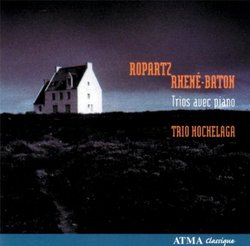Two Breton Piano Trios
J Scott Morrison | Middlebury VT, USA | 11/04/2007
(4 out of 5 stars)
"Joseph Guy Ropartz (1864-1955) and René-Emmanuel Bâton (who preferred to be called simply Rhené-Baton, the latter without the 'a circonflex') (1879-1940) had much in common. Each was Breton, Ropartz by birth and Rhené-Baton by choice, each was in the Franck-D'Indy school of composers, and each wrote his piano trio within five years after the end of the First World War.
Ropartz's Piano Trio in A Minor (1918) was written while he was director of the conservatoire in Nancy. It is in the usual three movements and has the typical Franckian cyclic form and frequent modulations. The first movement is restless, with almost unceasing piano sixteenth-note arpeggios, suggesting to the booklet writer the ceaseless motion of the sea off the Breton coast. The second movement is angular and even abrupt at times but with a tender, lyrical trio. The finale is in two sections marked 'Lent' and 'Animé'. The first section begins with a plaintive single-line piano theme that is then joined by a soaring violin line and later a plaintive cello theme. The passage becomes more impassioned and leads to the second section which comprises a victorious-sounding theme that merges into a contrapuntal combination of the two themes and a return, á la Franck, to the sea theme of the first movement. The coda ends the work with a brisk reappearance of the triumphal theme.
Rhené-Baton's Piano Trio (1923), also in three movements, has Breton folk elements (including one melody that was later shown not to be Breton but which Rhené-Baton had found in a collection of supposed Breton songs). It begins with a melancholy unaccompanied melody of Rhené-Baton's own devising but which sounds like a Breton lament; it is soon transformed into a rough and spirited dance. The second movement has a subtitle, 'Divertissement sur un vieil air breton', the folksong mentioned above, which is accompanied by a throbbing naked-fifths drone in the bass which reminds one of a musette (or, to an American ear, an early Hollywood idea of Native American music). The finale begins softly, even tentatively, but it gains impetus and soon brings back the main themes of the first and second movements -- there's that Franckian cyclic form again -- and then combines the two skillfully.
These fine performances are by a French-Canadian group whose musicians are violinist Anne Robert, cellist Paul Marleyn, and pianist Stéphane Lemelin. (The group is called 'Trio Hochelaga', a name taken from the original Iroquois name for Montréal.) The recording is in lifelike sound.
Scott Morrison"

